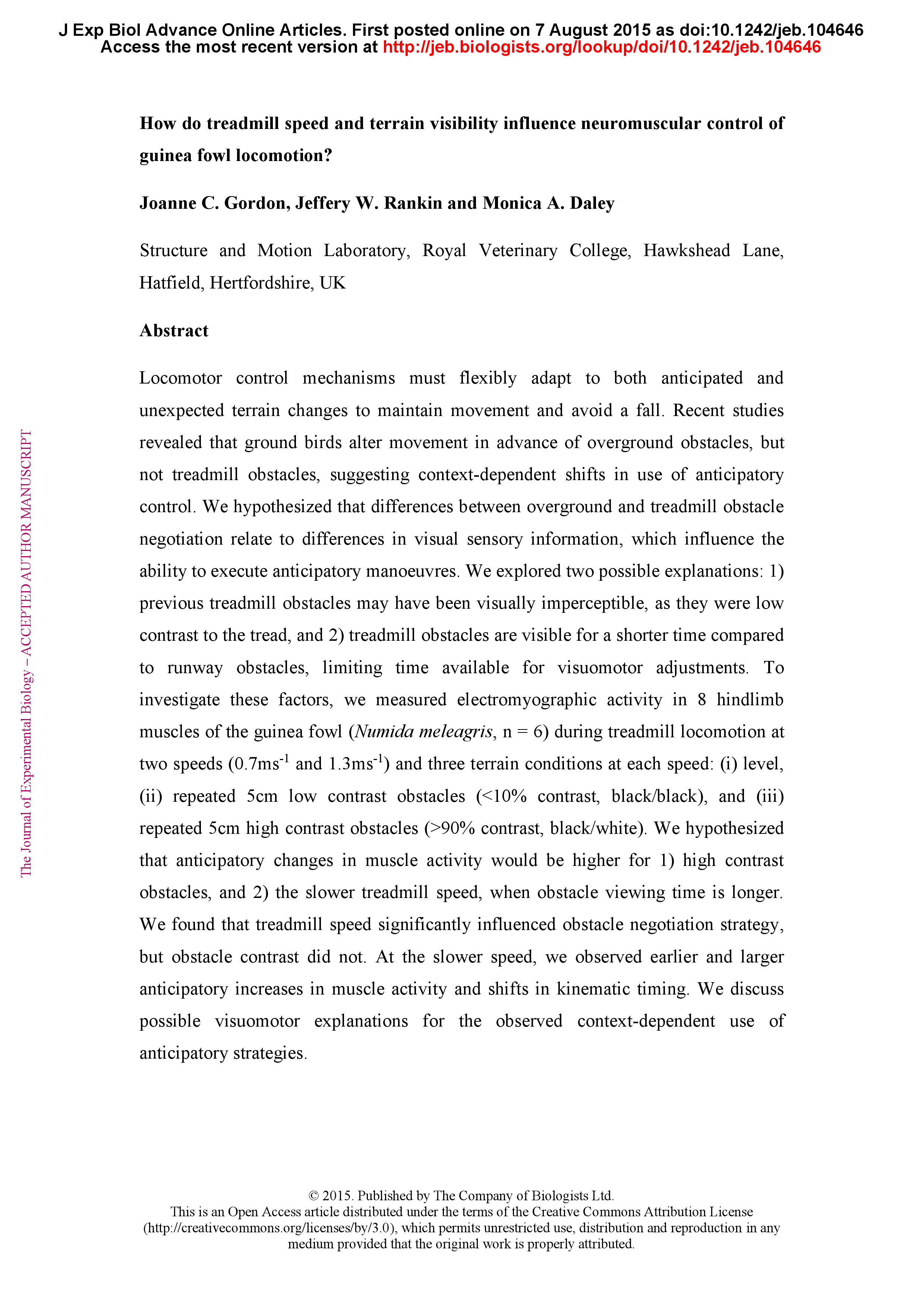Locomotor control mechanisms must flexibly adapt to both anticipated and unexpected terrain changes to maintain movement and avoid a fall. Recent studies revealed that ground birds alter movement in advance of overground obstacles, but not treadmill obstacles, suggesting context-dependent shifts in use of anticipatory control. We hypothesized that differences between overground and treadmill obstacle negotiation relate to differences in visual sensory information, which influence the ability to execute anticipatory manoeuvres. We explored two possible explanations: 1) previous treadmill obstacles may have been visually imperceptible, as they were low contrast to the tread, and 2) treadmill obstacles are visible for a shorter time compared to runway obstacles, limiting time available for visuomotor adjustments. To investigate these factors, we measured electromyographic activity in 8 hindlimb muscles of the guinea fowl (Numida meleagris, n=6) during treadmill locomotion at two speeds (0.7ms−1 and 1.3ms−1) and three terrain conditions at each speed: (i) level, (ii) repeated 5cm low contrast obstacles (<10% contrast, black/black), and (iii) repeated 5cm high contrast obstacles (>90% contrast, black/white). We hypothesized that anticipatory changes in muscle activity would be higher for 1) high contrast obstacles, and 2) the slower treadmill speed, when obstacle viewing time is longer. We found that treadmill speed significantly influenced obstacle negotiation strategy, but obstacle contrast did not. At the slower speed, we observed earlier and larger anticipatory increases in muscle activity and shifts in kinematic timing. We discuss possible visuomotor explanations for the observed context-dependent use of anticipatory strategies.
How do treadmill speed and terrain visibility influence neuromuscular control of guinea fowl locomotion?
Currently Viewing Accepted Manuscript - Newer Version Available
Joanne C. Gordon, Jeffery W. Rankin, Monica A. Daley; How do treadmill speed and terrain visibility influence neuromuscular control of guinea fowl locomotion?. J Exp Biol 2015; jeb.104646. doi: https://doi.org/10.1242/jeb.104646
Download citation file:
Advertisement
2023 JEB Outstanding Paper Prize shortlist and winner

The JEB Editors are delighted to announce the shortlisted authors for the 2023 JEB Outstanding Paper Prize. Read the winning paper - Tiny spies: mosquito antennae are sensitive sensors for eavesdropping on frog calls - by Hoover Pantoja-Sanchez and Brian Leavell from Ximena Bernal's lab at Purdue University, USA.
JEB Science Communication Workshop for ECRs

If you’re an early-career researcher interested in science communication and are attending the SEB Annual Conference in Prague this summer, come a day early and join the JEB Editors at a sci comm workshop to learn the key writing skills needed to promote your research to a broad audience beyond your peers (1 July at 14.30-17.30). Places are limited to 24 attendees, and applicants should apply through the SEB registration page by 30 April 2024.
Bridging the gap between controlled conditions and natural habitats in understanding behaviour

Novel technologies enable behavioural experiments with non-model species, in naturalistic habitats and with underexplored behaviours. In their Commentary, Scholz and colleagues discuss how to obtain a deeper understanding of the natural ecology and lifestyle of study animals.
Beluga metabolic measures could help save species

To help save animals from extinction, it’s important to understand what each species needs to survive. This led Jason John et al. to measure the metabolic rates of captive belugas to develop a ‘fish calculator’ showing that the whales need to eat ~23 salmon per day.
ECR Workshop on Positive Peer Review

Are you an ECR looking for tips on how to write concise, astute and useful manuscript reviews? If so, join the JEB Editors at a 2-hour JEB-sponsored Workshop on Positive Peer Review at the Canadian Society of Zoologists annual meeting in Moncton on 9 May 2024 at 13.00-15.00. There are 25 spaces for ECRs and selection is first come, first serve. To sign up, check the ECR Workshop box when you register for the CSZ meeting.



